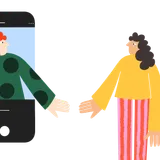
Is Your Brand Moving or Being Left Behind?
Motion design is no longer a nice-to-have. It is a must-have.
Imagine this: your phone buzzes, TikTok videos, Instagram stories, Spotify playlists fighting for your attention. Swipe. Scroll. Tap. Then, a bright billboard across the street moves. Subtle, but impossible to ignore. Everything is moving, everything is demanding to be seen. From Apple’s seamless app gestures to Netflix’s flickering previews, motion shapes our every interaction. These day-to-day examples show how motion now drives the competitive digital marketplace, influencing how we notice, engage with, and remember brands.
Attention in the Digital-First Economy
We live in a digital-first economy, where screens are ever-present and attention has become one of the most valuable and scarcest assets; one that brands must compete to earn.
Endless feeds, short-form videos, and constant notifications from a myriad of apps pull our focus in a hundred directions every single day. Studies (Arnold, 2023; Shanmugasundaram, 2023; Haliti-Sylaj, 2024) are raising big red flags, emphasizing how most of us can’t stay locked on a single message for more than a few seconds, while ADHD diagnoses are skyrocketing and our collective patience quietly vanishing.
We live in a digital-first economy, where screens are ever-present and attention has become one of the most valuable and scarcest assets, one that brands must compete to earn.
Capturing attention thus has almost become somewhat of a mission impossible, and yes I might be (slightly) exaggerating, but it’s really not that far from the truth. As McKinsey & Company (2025) note, in today’s attention economy, focus is a rare and prized commodity, and brands must earn their share (a 10% increase in average focus is associated with a 17% increase in consumer spend across media¹).
When Karvalics (2007) described the concept of an “information society,” he didn’t foresee how quickly information would flood every channel. But here we are, swimming through the so-called attention economy. Arnold, Goldschmitt, and Rigotti (2023) highlight how, content has never been more abundant, or harder to filter, making this digital overload a widespread problem.
Therefore, in this oversaturated digital landscape, brands aren’t just competing for attention, they are competing to stand out, differentiate, and stay relevant. In a recent report (2025), McKinsey & Company emphasised that “in a digital environment defined by abundance, distraction, and fragmentation, organizations that understand attention’s true value (and how it varies by consumer) should come out ahead.”
Ultimately, for brands, leveraging motion is no longer a nice-to-have. It is a must-have.
Ultimately, for brands, leveraging motion is no longer a nice-to-have. It is a must-have.
The Power of Motion In Brand Storytelling
How to cut through the noise?
Storytelling enters the chat.
The answer to digital overload and our ever-shrinking attention spans is strategic storytelling. In a crowded digital market, brands cannot simply afford to hope to be noticed; they have to earn it with stories that stick and resonate. We humans, the social animals we are, we love stories. They are hardwired into us. We remember them, feel them, and yes, we even share them (Das, 2024; Hamby, 2019). Motion is the power that brings brand stories to life, making them stick and unforgettable. When done right, motion becomes a behavioral tool; guiding focus, boosting engagement, and increasing the likelihood of content being remembered and shared. But static visuals? Flat images, logos, or text that don’t move, struggle in a scroll-first world. As Paget (2016) puts it, “brand elements can’t afford to just appear static; they need to move, flow, and live in these new digital spaces.”
Now, broadly speaking, motion graphics transform modern branding and marketing, giving companies new ways to drive deep engagement through immersive visuals. What motion does is amplify storytelling, turning it into a living, attention-grabbing experience that actually stick. In the first seconds, motion onset captures the eye and directs gaze (Zhang, York & Jonides, 2025; Lunghi & Di Giorgio, 2024), and brief, purposeful animation lifts focus and understanding (Yang & Gan, 2025).
The Core Pillars of Motion in Branding
Think of motion design as storytelling with a pulse. Motion gives your brand the pulse it needs to stay alive. Animated logos, micro-interactions, and short narrative arcs guide attention, convey personality, and encourage sharing. Done well, motion streamlines processing and strengthens memorability (Barut Tugtekin & Dursun, 2022). Building on this, Das (2024) emphasizes three core pillars for motion in branding:
1. Visual storytelling
Motion controls time—hook, order, pace—so emotion lands and meaning sticks.
2. Brand differentiation
A codified motion language of durations, easing, sequencing, and rhythm makes the brand recognizable and coherent across touchpoints.
3. Audience engagement
Brief, purposeful animation earns the first seconds and aids understanding; tune pacing and density to audience and platform.
Applied consistently, motion becomes a repeatable behavior that guides focus, builds memory, and increases the odds of recall and sharing. Ultimately, a brand behaves like a person. It talks differently, moves differently, and is remembered for it
A closer look at Mucho´s Cases
At Mucho, motion isn’t an afterthought—it’s a valuable storytelling device embedded in our work. Here are a few examples:
Piedmont Art Walk
Letters moved along pathways, reflecting the act of walking through an outdoor exhibition. Visitors could see the brand breathe as they explored, creating a kinetic mirror of the physical experience.
Stem Grove Festival
The symbol reacted in real time to sound, translating beats into motion. Audience engagement increased because the brand felt alive, reacting to its environment.
Bash
Sound came first. Movement followed, amplifying the multicultural, dynamic personality of the brand. Characters and typographic elements danced in sync with sound, creating surprise and memorability, while amplifying the brand’s multicultural, dynamic personality.
Ultraderp
Even small movements can convey meaning. The animated “U” takes the shape of the tongue, showing curiosity and playfulness, showing how subtle motion reinforces personality without overwhelming.
This project has recently earned us a Brand Impact Silver award. Find out more here.
These projects demonstrate motion as a strategic, intentional tool rather than decorative sparkle. It amplifies storytelling, reinforces values, and makes brands feel alive.
Final Thoughts
Brands today are battling for attention, trust, and community. In a crowded digital space, motion cuts through the noise, turning design into behavior, giving brands purpose. It’s not decoration—it’s strategy. Keep it brief, playful, and easy to follow. Design for the platform so motion guides, not distracts. It’s the grammar that conveys tone and story. Static brands fade; motion-led brands build trust and connection.
Key Takeaways:
- - Motion is a strategic layer, not decoration. It’s what transforms design from static identity into living behavior, guiding how a brand speaks, feels, and connects.
- - Define the system early—tempo, easing, and timing, to ensure motion feels intentional.Design with context in mind.
- - Adapt motion to platform, context, and accessibility.
- - Build motion into the brand’s DNA to direct attention, express personality, and ensure consistency across all touchpoints.
Ultimately, when motion moves with purpose, meaning moves with it, and people do too.
Burning Question: In a world where everything is fighting for your attention, how does your brand stand out?


